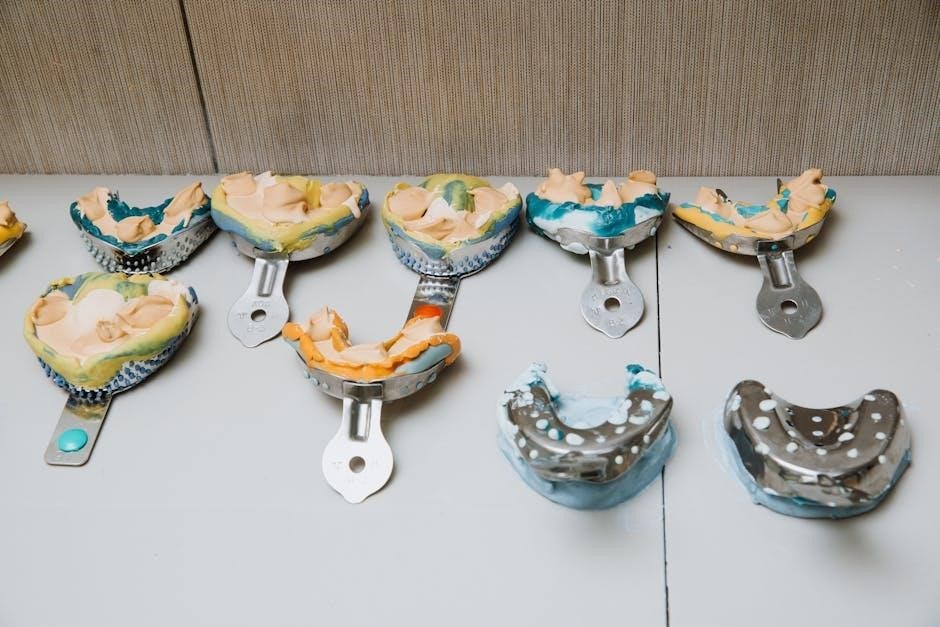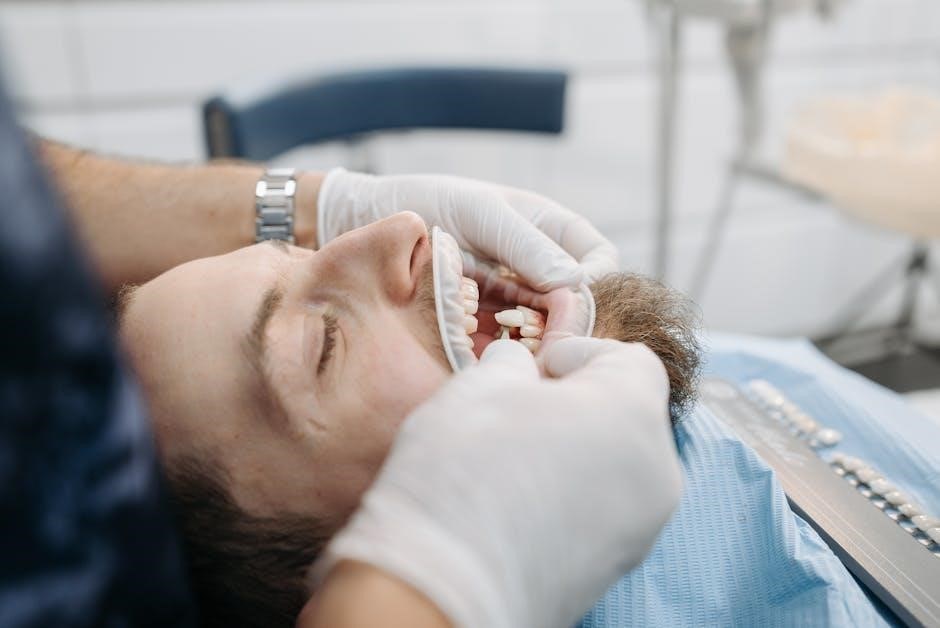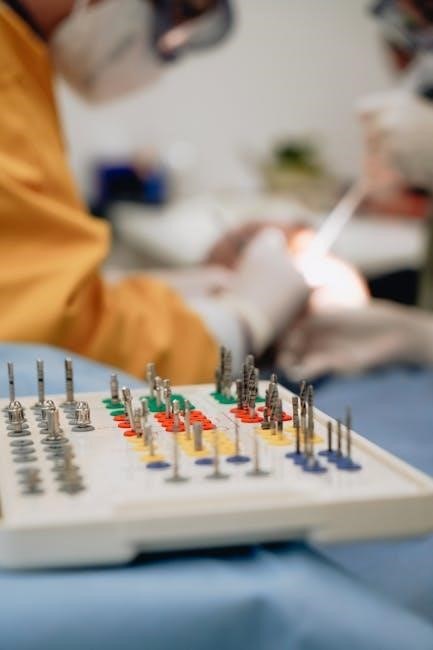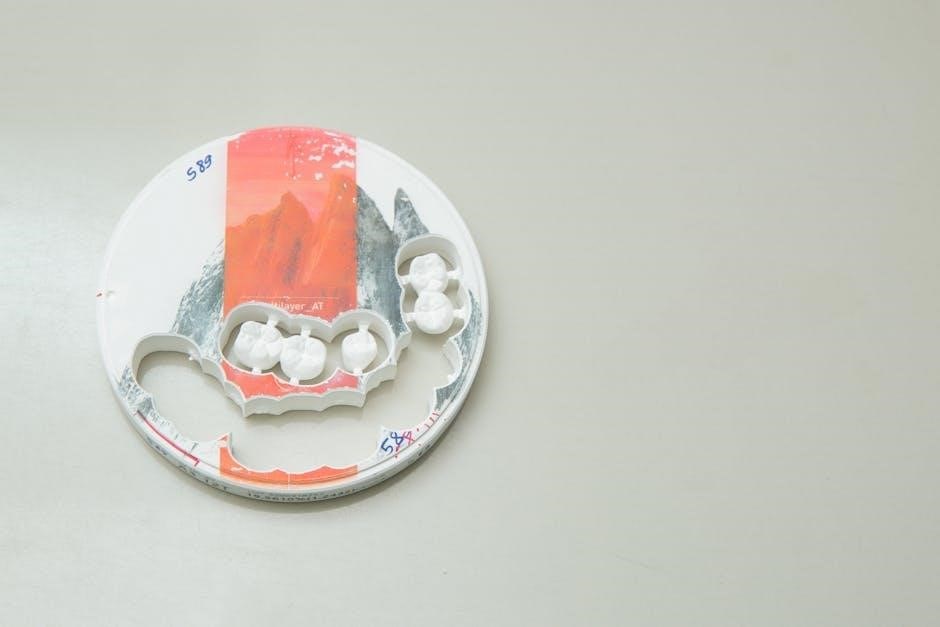Discover the importance of denture teeth shape in restoring both aesthetics and function. This guide explores how shape influences comfort, chewing efficiency, and overall facial harmony, ensuring a natural look.
Understanding the Importance of Denture Teeth Shape
Denture teeth shape plays a crucial role in both aesthetics and function. Properly shaped teeth enhance facial appearance by restoring natural contours and symmetry. They also improve chewing efficiency, speech clarity, and overall comfort. The right shape ensures a balanced smile, aligning with individual facial features and mouth structure. This customization is key to creating dentures that look and feel natural, boosting confidence and quality of life for wearers.
Overview of Denture Types and Their Teeth Shapes
Dentures come in various types, each with distinct teeth shapes tailored to specific needs. Partial dentures feature teeth shaped to blend with existing natural teeth, ensuring a seamless appearance. Full dentures often use standardized shapes for uniformity, while implant-supported dentures allow for highly customized teeth forms. The choice of shape depends on the denture type, with options ranging from oval to square, each designed to enhance aesthetics, functionality, and patient comfort.
Factors Influencing Denture Teeth Shape
Denture teeth shape is influenced by facial aesthetics, mouth size, age, gender, and functional needs. These factors ensure a balanced, natural appearance and optimal chewing efficiency.
Facial Structure and Its Impact on Denture Aesthetics
Facial structure significantly influences denture aesthetics, as denture teeth must complement facial contours, symmetry, and proportions. The shape and size of denture teeth are tailored to harmonize with individual facial features, ensuring a natural and balanced appearance. Proper alignment and proportions help maintain facial harmony, while incorrect shapes can distort the overall look. This customization ensures that dentures not only restore function but also enhance aesthetic appeal, creating a cohesive and natural-looking smile.
Mouth Size and Shape Considerations
Mouth size and shape play a crucial role in determining denture teeth shape, ensuring proper fit and functionality. Denture teeth must align with the mouth’s natural contours, considering factors like arch width and palate shape. Proper sizing prevents overcrowding or excessive spacing, enhancing both comfort and aesthetics. A prosthodontist assesses the mouth’s dimensions to select teeth that harmonize with the individual’s oral anatomy, ensuring a natural appearance and optimal chewing efficiency.
Age and Gender-Specific Denture Teeth Shapes
Denture teeth shapes are tailored to age and gender to achieve a natural, harmonious appearance. Younger patients often prefer more defined, vibrant shapes, while older individuals may opt for softer, less pronounced contours. Gender-specific designs consider facial features, with feminine teeth slightly more rounded and masculine teeth broader. These customizations ensure dentures complement individual characteristics, enhancing both aesthetics and confidence, while maintaining functional efficiency for optimal patient satisfaction.

Denture Teeth Shape and Aesthetics
Denture teeth shape significantly impacts facial aesthetics, smile symmetry, and overall appearance. Properly designed shapes enhance natural beauty, restoring confidence and ensuring a harmonious, personalized look.
How Denture Teeth Shape Affects Facial Appearance
Denture teeth shape plays a crucial role in facial aesthetics, influencing smile symmetry and overall facial harmony. Properly shaped teeth restore natural contours, supporting the lips and cheeks for a more youthful appearance. Misaligned or ill-fitting shapes can flatten facial features, while well-designed ones enhance definition and balance. The right shape ensures a natural look, boosting confidence and improving overall facial aesthetics, making dentures nearly indistinguishable from natural teeth in both function and appearance.
Color and Shade Matching for Natural Look
Color and shade matching are essential for creating a natural appearance in dentures. Teeth shades are carefully selected to blend with surrounding dental structures, ensuring a seamless aesthetic integration. Advanced techniques allow for personalized shade selection, enhancing the natural look and boosting patient confidence. Proper shade matching not only improves facial aesthetics but also ensures harmony with the patient’s skin tone and existing teeth, making dentures indistinguishable from natural ones in both color and overall appearance.
Enhancing Smile Symmetry with Proper Teeth Shape
Properly shaped denture teeth are crucial for achieving smile symmetry, a key factor in facial aesthetics. The alignment and proportion of teeth significantly impact the balance of the smile. Misshapen or uneven teeth can create asymmetry, affecting the overall appearance. By carefully selecting and shaping denture teeth to match the patient’s facial features, symmetry is restored, resulting in a more natural and harmonious smile. This enhances both aesthetic appeal and patient confidence, ensuring a balanced and pleasing facial expression.

Denture Teeth Shape and Function
Denture teeth shape directly impacts chewing efficiency, speaking clarity, and overall comfort. Properly designed teeth ensure optimal function, supporting daily activities like eating and speaking with confidence and ease.
Chewing Efficiency and Teeth Shape
The shape of denture teeth significantly influences chewing efficiency. Sharp, pointed teeth are ideal for tearing food, while flat surfaces are better for grinding. Proper alignment ensures even force distribution, preventing denture shifting during chewing. Rounded teeth often provide a balance, offering both functionality and comfort. The material and durability of teeth also play a role, with harder materials lasting longer. Custom-shaped teeth can address specific chewing challenges, ensuring optimal performance. Regular maintenance is crucial to preserve shape and function over time.
Speaking Clarity and Denture Teeth Alignment
Denture teeth alignment plays a crucial role in maintaining speaking clarity. Properly shaped and aligned teeth ensure precise pronunciation and articulation, reducing mumbling or distorted sounds. Misaligned teeth can hinder speech, making it difficult to form certain words. The shape of the teeth, particularly the incisal edges, affects how the tongue and lips interact during speech. A well-designed denture with accurate alignment enhances verbal communication, restoring confidence in everyday interactions. This guide emphasizes the importance of customization for optimal speech outcomes.
Comfort and Fit: The Role of Teeth Shape
The shape of denture teeth significantly impacts comfort and fit. Properly designed teeth distribute chewing forces evenly, preventing irritation to the gums and surrounding tissues. A well-contoured shape minimizes pressure points, ensuring a snug fit and reducing the risk of discomfort or movement during use. Additionally, the shape influences how the denture sits in the mouth, affecting overall stability and wearability. Customizing the teeth shape to the individual’s oral anatomy enhances long-term comfort and satisfaction.

Types of Denture Teeth Shapes
Denture teeth shapes include round, square, and ovate options, each offering distinct aesthetic and functional benefits; Round teeth provide a softer appearance, while square teeth enhance definition.
Round Teeth Shape for a Softer Look
Round teeth shapes are popular for their natural, gentle appearance, offering a softer smile. They are ideal for individuals seeking a less defined look, blending seamlessly with facial contours. This shape minimizes angularity, creating a more youthful and approachable aesthetic. Round teeth are often recommended for those with smaller mouth sizes or round facial structures, as they enhance harmony and comfort, ensuring a natural, understated smile that avoids a rigid or artificial appearance.
Square Teeth Shape for a More Defined Smile
Square teeth shapes offer a bold, defined smile with angular contours, creating a striking aesthetic. They are ideal for individuals seeking a more prominent look, often complementing larger facial structures or square face shapes. This shape enhances the upper and lower arches, contributing to a balanced and confident appearance. Square teeth are durable and resistant to wear, making them a practical choice for those prioritizing both style and functionality in their denture design.
Ovate Teeth Shape: A Balance Between Round and Square
Ovate teeth shape combines the softness of round teeth with the definition of square teeth, creating a natural, harmonious smile. This versatile shape suits various facial structures, blending seamlessly with individual aesthetics. Ovate teeth are slightly tapered at the edges, offering a balanced look that enhances smile symmetry. They are ideal for patients seeking a compromise between round and square shapes, providing both comfort and a visually appealing result. This shape is widely used for its adaptability and ability to complement diverse facial features.

Denture Teeth Shape and Materials
Denture teeth shape and materials significantly impact durability, aesthetics, and comfort. Acrylic teeth offer a natural look, while porcelain enhances strength. Modern materials enable precise shape customization for optimal fit and function.
Acrylic vs. Porcelain Teeth: Shape and Durability
Acrylic vs. porcelain teeth differ significantly in shape and durability. Acrylic teeth are more flexible and cost-effective, offering a natural appearance but less durability. Porcelain teeth are harder and more long-lasting, providing a realistic look but requiring precise shaping. Acrylic is ideal for temporary solutions, while porcelain suits permanent dentures. The choice depends on individual needs, balancing aesthetics, durability, and comfort for optimal results.
Implant-Supported Dentures: Custom Teeth Shapes
Implant-supported dentures offer custom teeth shapes tailored to individual needs, ensuring optimal fit and function. These dentures are anchored to dental implants, providing exceptional stability and durability. Custom shaping enhances chewing efficiency and speaking clarity, while the natural appearance boosts confidence. Advanced CAD/CAM technology allows precise design, ensuring teeth align perfectly with the jawbone. This solution combines aesthetics and functionality, offering long-term comfort and a realistic smile for patients seeking permanent, high-performance dentures.
3D-Printed Denture Teeth: Precise Shape Control
3D-printed denture teeth offer unparalleled precision in shape control, enabling highly customized solutions. Utilizing advanced digital models, each tooth is crafted layer-by-layer to match individual patient needs. This method ensures a natural appearance, improved fit, and enhanced durability. The process streamlines production, reducing errors and speeding up delivery. Patients benefit from tailored aesthetics and functionality, making 3D-printed dentures a cutting-edge option for achieving a lifelike smile with optimal comfort and performance.

Trends in Denture Teeth Shape Design
The field of denture teeth shape design is evolving rapidly, driven by advancements in CAD/CAM technology, personalized solutions, and the use of sustainable materials.
CAD/CAM Technology for Custom Teeth Shapes
CAD/CAM (Computer-Aided Design/Computer-Aided Manufacturing) technology revolutionizes denture teeth shape design by enabling precise digital models. This advanced system allows for highly customizable teeth shapes, ensuring optimal aesthetics and function. Dentists can create detailed 3D models, adjust proportions, and simulate outcomes. The process streamlines production, reduces errors, and enhances fit. CAD/CAM also integrates with implant planning, offering tailored solutions for complex cases. Its versatility meets individual patient needs, making it a cornerstone of modern denture design.
Personalized Denture Teeth Shapes for Individual Needs
Personalized denture teeth shapes cater to unique facial structures, mouth sizes, and aesthetic preferences. Advanced technologies allow dentists to craft teeth that align with individual facial contours, ensuring natural aesthetics. Patients can choose shapes that mirror their natural teeth or opt for improvements. This tailored approach enhances comfort, chewing efficiency, and speaking clarity. By addressing specific needs, personalized dentures boost confidence and overall satisfaction, offering a seamless transition to a restored smile.
Sustainable Materials and Their Impact on Teeth Shape
Sustainable materials are revolutionizing denture teeth shape by offering eco-friendly options without compromising on quality. Biocompatible resins and recycled ceramics are now being used, reducing environmental impact. These materials maintain durability while promoting lightweight, natural aesthetics. Innovations in sustainable denture materials enable precise shaping to mimic natural teeth, enhancing both comfort and appearance. As demand grows, sustainable options continue to advance, ensuring ethical and environmentally conscious choices for patients seeking modern denture solutions.

Choosing the Right Denture Teeth Shape
Selecting the ideal denture teeth shape involves considering facial structure, mouth size, and personal preferences. A prosthodontist can guide you through the process for optimal results.
Consultation with a Prosthodontist
A consultation with a prosthodontist is crucial for selecting the right denture teeth shape. They evaluate facial structure, mouth size, and lifestyle to recommend the most suitable options. Using advanced tools like 3D imaging, they ensure a natural look and optimal function. This personalized approach helps achieve a smile that aligns with individual aesthetics and improves confidence. Regular follow-ups during the process ensure satisfaction and proper fit.
Try-In Process for Optimal Shape Selection
The try-in process is a critical step in ensuring the optimal shape and fit of denture teeth. Temporary dentures or mockups are created to allow patients to see and approve the shape, size, and shade of their teeth. During this stage, adjustments can be made based on patient feedback to enhance aesthetics and function. This step ensures the final dentures meet individual preferences and provide a natural, comfortable fit. It’s a key part of achieving patient satisfaction and confidence in their new smile.
Patient Satisfaction and Teeth Shape Customization
Patient satisfaction is deeply tied to the customization of denture teeth shape, ensuring a tailored fit and appearance. Personal preferences, facial structure, and lifestyle are considered to create natural-looking dentures. Advanced technologies like CAD/CAM enable precise adjustments, enhancing both aesthetics and comfort. Regular feedback during the fitting process ensures the final result meets the patient’s expectations, boosting confidence and overall satisfaction with their new smile. Customization plays a vital role in achieving a seamless, personalized dental solution.

Maintenance and Care of Denture Teeth Shape
Proper cleaning, storage, and regular check-ups are essential for maintaining denture teeth shape. Daily care ensures longevity, while professional adjustments prevent wear and tear over time.
Cleaning Techniques to Preserve Teeth Shape
Regular cleaning is crucial to maintain denture teeth shape and prevent wear. Use a soft-bristled brush and mild detergent to gently remove plaque and stains. Soaking dentures in a cleaning solution can help loosen debris without damaging the material. Avoid harsh chemicals or abrasive cleaners, as they may alter the shape or shade of the teeth. Proper cleaning techniques ensure a natural appearance and functional longevity of the dentures.
Adjustments and Repairs for Long-Term Fit
Regular adjustments and timely repairs are essential to maintain the shape and fit of denture teeth. Over time, natural jaw changes or wear can alter the fit, requiring professional modifications. A prosthodontist can reshape or reline dentures to restore comfort and aesthetics. DIY repairs are discouraged, as they may damage the structure. Proper maintenance ensures long-term functionality and prevents further complications, keeping the denture teeth in optimal shape for years.
Regular Check-Ups to Maintain Optimal Shape
Regular check-ups with a prosthodontist are crucial to ensure denture teeth retain their optimal shape and fit. During these visits, the dentist examines the dentures for wear, misalignment, or damage. Adjustments are made to maintain aesthetics and functionality. Check-ups also help identify potential issues early, preventing complications. By scheduling routine appointments, patients can ensure their dentures continue to look natural and perform effectively, maintaining long-term satisfaction and oral health.

Case Studies and Real-Life Examples
Explore real-life transformations where customized denture teeth shapes restored smiles, improved function, and enhanced confidence. These examples highlight the impact of proper shape selection on patient satisfaction.
Success Stories of Denture Teeth Shape Transformation
Real-life examples showcase how tailored denture teeth shapes transformed lives. Patients with unique needs, like Soren Roe, born without teeth due to ectodermal dysplasia, found renewed confidence. Advanced techniques ensured natural aesthetics and functionality. A video guide highlights selecting the ideal shape, size, and shade for dentures, demonstrating transformative results. These stories illustrate how personalized teeth shapes restore smiles, improve chewing efficiency, and boost overall quality of life, proving the impact of precise dental solutions.
Challenges in Achieving Ideal Teeth Shape
Achieving the perfect denture teeth shape can be complex, as it must align with facial structure, mouth size, and personal aesthetics. Challenges include balancing functionality with natural appearance, addressing material limitations, and ensuring precise measurements. Factors like age, gender, and individual oral anatomy add layers of complexity. Additionally, achieving symmetry and proper alignment requires meticulous craftsmanship. These challenges highlight the importance of working with a skilled prosthodontist to customize teeth shapes for optimal results and patient satisfaction.
Innovative Solutions for Complex Cases
Modern advancements in denture technology offer innovative solutions for complex cases. CAD/CAM systems enable precise digital modeling of teeth shapes, ensuring optimal fit and aesthetics. 3D printing allows for rapid prototyping and customization, addressing unique challenges like asymmetrical faces or limited jaw support. Implant-supported dentures provide stability and natural-looking results, even for patients with extensive tooth loss. These cutting-edge approaches help prosthodontists create tailored solutions, overcoming traditional limitations and delivering superior comfort, functionality, and appearance for patients with complex needs.
Final Thoughts on Denture Teeth Shape Guide
The shape of denture teeth significantly impacts both aesthetics and functionality, ensuring a natural appearance and optimal performance. Properly designed denture teeth enhance facial harmony, chewing efficiency, and speech clarity. With advancements in materials and technology, such as CAD/CAM and 3D printing, customization options have expanded, allowing for more personalized solutions. Consulting a prosthodontist and leveraging modern techniques ensures the best outcomes for patients seeking tailored, durable, and aesthetically pleasing dentures.
Future Trends in Denture Teeth Shape Design
Advancements in technology, such as CAD/CAM and 3D printing, are revolutionizing denture teeth shape design, enabling precise customization. Biocompatible materials and AI-driven tools will enhance aesthetics and functionality. Personalized solutions tailored to individual needs are expected to rise, offering improved comfort and durability. These innovations will make dentures more natural-looking and long-lasting, addressing diverse patient requirements with greater efficiency and satisfaction.

Resources and Further Reading
Explore recommended literature, online tools, and professional organizations for in-depth insights into denture teeth shape guide. Utilize CAD/CAM technology and resources for personalized solutions and updates.
Recommended Literature on Denture Teeth Shape
Key resources include textbooks on prosthodontics, focusing on denture aesthetics and functional design. Journals like the Journal of Prosthetic Dentistry offer in-depth studies on teeth shape trends. Books such as Dental Materials by Dr. Jane Smith and Modern Denture Design by Dr. Michael Brown provide insights into materials and aesthetics. Online databases like PubMed and Google Scholar offer access to recent research on CAD/CAM technology and personalized denture solutions. These sources ensure a comprehensive understanding of denture teeth shape evolution and innovations.
Online Tools for Exploring Denture Teeth Shapes
Utilize online platforms like the Prosthodontic Terms Glossary from the Academy of Prosthodontics for detailed terminology. Websites such as removpros.dentistry.dal.ca offer guides on selecting denture teeth. CAD/CAM software like DentalCAD allows visualization of custom shapes. YouTube tutorials provide step-by-step insights into shape selection. Additionally, Google Scholar offers access to research papers on advanced materials and techniques. These tools empower users to explore and understand denture teeth shapes effectively.
Professional Organizations for Denture Care
Professional organizations like the American Dental Association (ADA) and the Academy of Prosthodontics provide valuable resources for denture care. The National Institute of Dental and Craniofacial Research (NIDCR) offers insights into oral health and denture-related research. These organizations promote education, research, and clinical excellence in denture care, ensuring patients receive high-quality treatments. They also set standards for denture teeth shape and material selection, supporting both professionals and patients in achieving optimal outcomes.



0 Comments